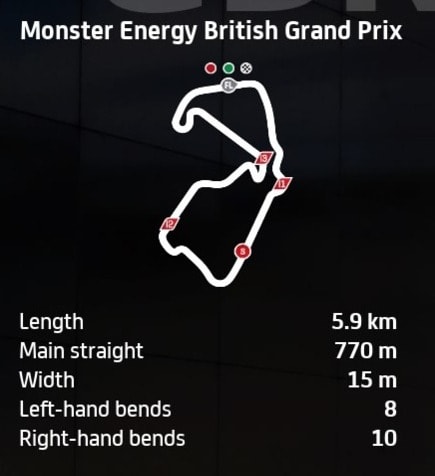The Silverstone circuit has been on the MotoGP calendar for well over a decade now, taking over from Donington. And it’s a tricky circuit to navigate on bike, simply because it’s so long with so many braking zones and technical sequences of corners you need to get right to string a lap together.

You’re looking at 2 minute lap times on MotoGP bikes, and even longer for lower bike classes. So you need a setup you feel comfortable with, and also a lot of practice to memorize the track well.
Here’s a MotoGP class bike setup for Silverstone on MotoGP 23:
- Suspension (Front Fork):
-
- Front pre-load – 2
- Oil Quantity – 1
- Front Spring Hardness – 4
- Front Swingarm compression – 4
- Front Swingarm extension – 3
-
- Rear Single Shock Absorber:
-
- Rear Pre-load – 4
- Swingarm connector – 4
- Rear spring hardness – 2
- Single shock absorber compression – 4
- Single shock absorber extension – 3
-
- Vehicle Geometry:
-
- Steering head inclination – 2
- Trail – 4
- Steering plate position – 3
- Rear swingarm length – 4
-
- Transmission:
-
- Gears (1-6) – 5-5-4-4-4-3
- Final ratio – 4
- Slipper clutch – 7
-
- Brakes:
-
- Front disc – 355 mm High Mass
- Rear disc – 220mm
-
- ECU
-
- Traction control – 5
- Engine braking – 4
- Anti-wheelie – 3
- Power mapping – 2
-
I felt the most comfortable and consistent using this setup, but honestly it took a lot of practice to get even remotely confident on this track regardless of the setup used. It’s just a tricky circuit to get right lap after lap and you need your braking and turn in points memorised for all corners (more on this further below).
For the front brake disc, you can also try the 340 mm High Mass one, which makes the braking a bit easier but delivers less stopping power. I went for the 355mm in the end as I want the braking power, but some of the braking zones are really challenging here so you can go lower if you want. Also a lot of players use a lower TC value than me.
I did also try a modded version of my generic setup, which is already pretty similar to the setup above, with just the gears, brake and ECU settings ported over to match this one. It also felt OK, but after going back and forward testing the two, the above setup felt a bit better.
Moto2 and Moto3 Bike Setups For Silverstone
The less powerful Moto2 and Moto3 bikes are a bit easier to handle around here, with more time to react to corners and get ready for braking zones. Get ready for some seriously long lap times though – up to 2:15 and even longer in wet, as it’s such a long track.
If you want setups for these bikes, check out my generic setups page for MotoGP 23, which also has generic starter setups for Moto2/Moto3 that you can test against the default game setup to find improvements.
Tips For Riding Around Silverstone
It’s not easy to get all the corners at Silverstone bang on and put together consistent laps one after another. It can take quite a lot of practice – like 20+ laps – to really learn the corners and get into a rhythm here.
Here’s some extra tips for riding this circuit:
Braking technique – This game really does not like it when you try to lean whilst applying the front brake. And there’s quite a few tricky braking zones at this track that kind of tempt you to do just that. Get all your initial braking done in a straight line when the bike is fully upright. Then you can dab the rear brake on it’s own if needed to aid with cornering.
Turn 1-2-3 – Braking point is just as the kerbing starts on your left. Turn 2 is a pretty easy left hander, and then as soon as you exit 2 and the bike is upright again, immediately lift off the power and start braking for the right hander of turn 3. It’s quite a sharp corner so brake early and use the rear brake if needed to tuck the bike in.
Turn 6 – This is the long left hander “Brooklands” corner that comes after the short back straight. Braking point on MotoGP bikes is about 1 second after you pass the overhead bridge.
Copse Corner – This is the old turn 1, the fast right hander after the old pit straight. Braking point is just as you reach the overhead sign. Apply the front brake firmly but briefly, then release and lean into this wide open corner, adding some rear brake if needed to lean the bike in more.
Maggots/Becketts “esses” – This is the now famous left-right-left-right-left esses section. Just needs practice and repetition to get it right on a MotoGP bike. Here’s a rough guide for each of the apexes:
- First apex (left hander) – Braking point is just after you pass the pit exit white lines pointing towards the “esses”. Apply the front brake then lean in.
- Second apex (right hander) – Literally as soon as you hit the first apex, immediately lean over for the second one without applying any throttle or brakes.
- Third apex – Just need a very slight dab on the accelerator after exiting the second corner, before you lift and lean in again for the next left.
- Fourth apex – Just needs an even more brief dab on the power coming out of 3, before you lift and lean in again.
Stowe Corner – The long right hander after the Hangar Straight following the esses. It’s a tricky braking zone as there’s no real reference point. As a rough guide, start braking about 1.5 seconds or so after you hit 6th gear on MotoGP bikes.
Vale Corner – This is the left hander after exiting Stowe and is very tricky as it’s a downhill braking zone. Always err on the side of braking earlier rather than later on this corner – before you reach the overhead sign. Apply the front brake only very briefly and don’t hold it on as it causes lock-ups and “stoppies”. Dab and release it a couple of times if needed, and then some rear brake can also help lean into the sharp left hander before you take the final two right handers to finish the lap.
Wet races – You’ll often encounter the famous terrible British weather here, and have to deal with wet qualifying/race sessions, which make this track even harder. See our guide for racing in the wet to help with this, but be warned that it’s a real challenge to stay on the bike here in wet conditions.
Mastering Silverstone (Track Guide)

